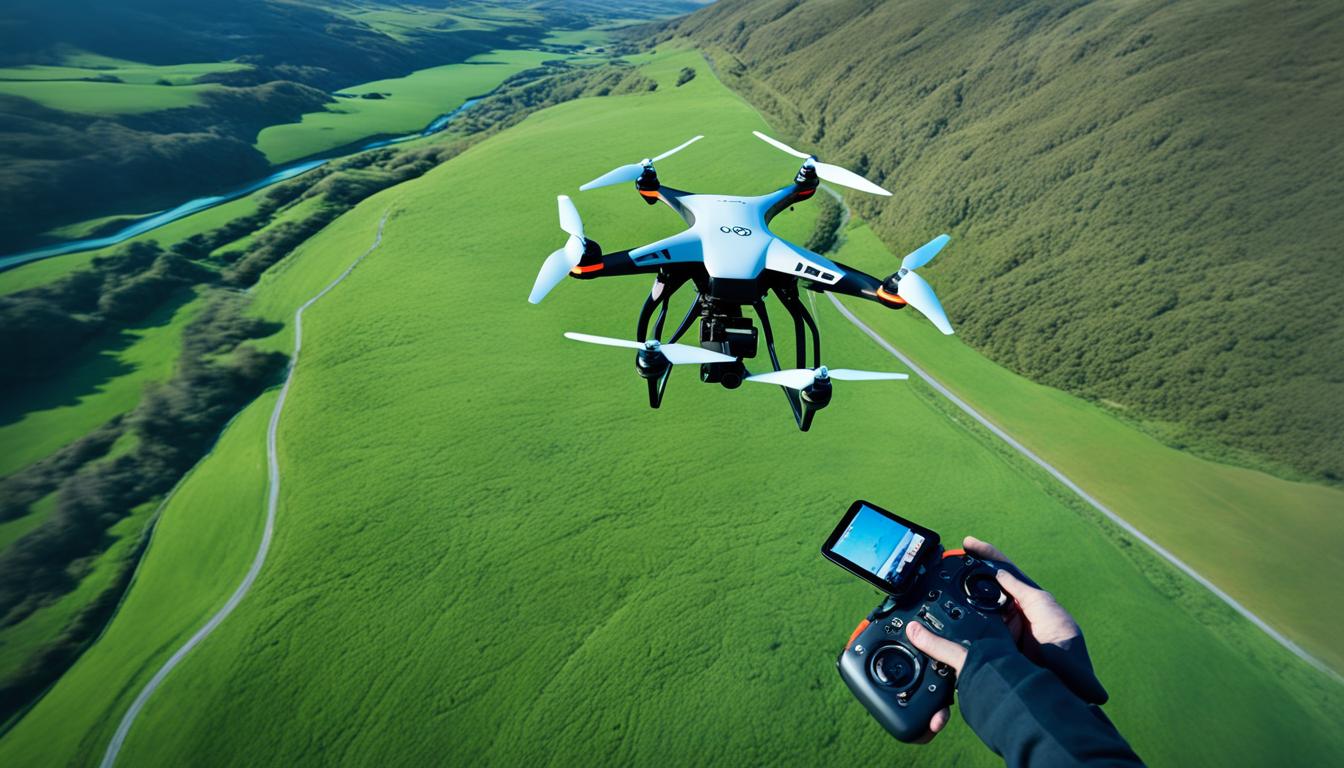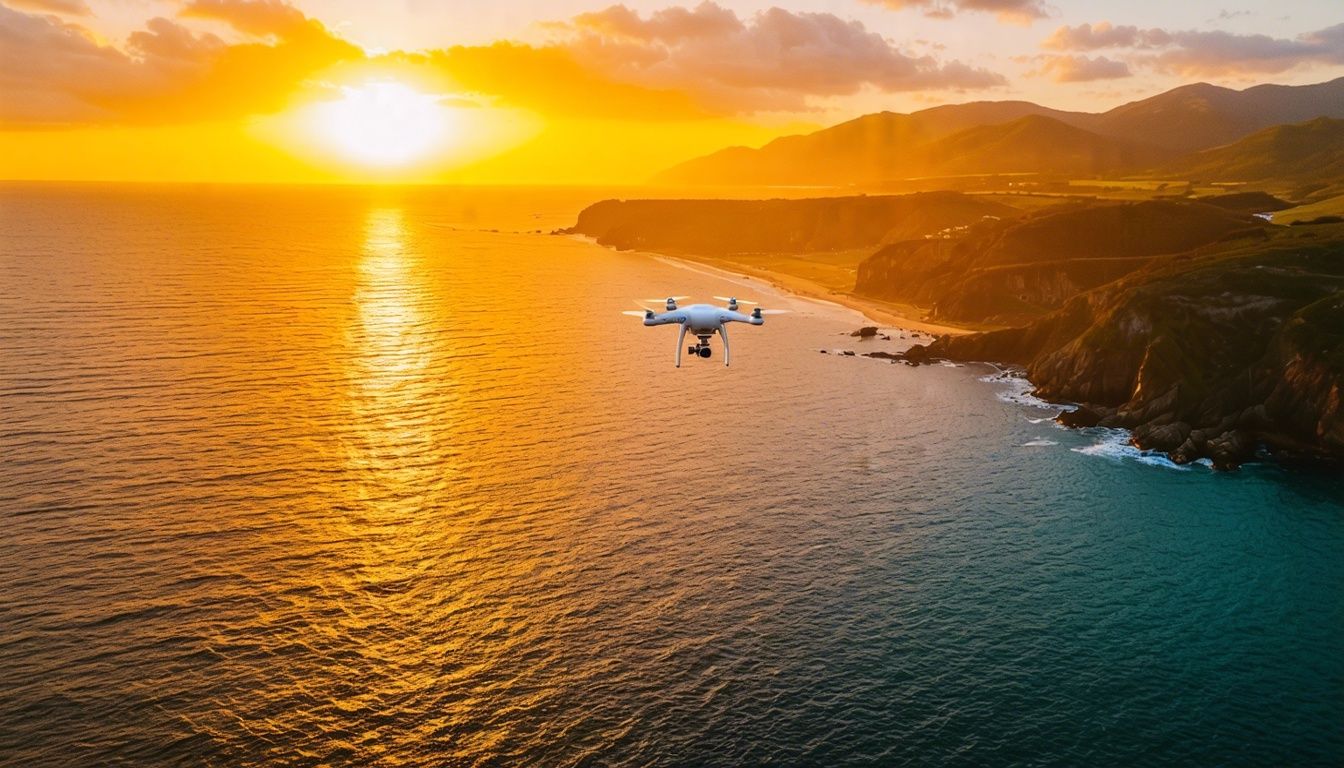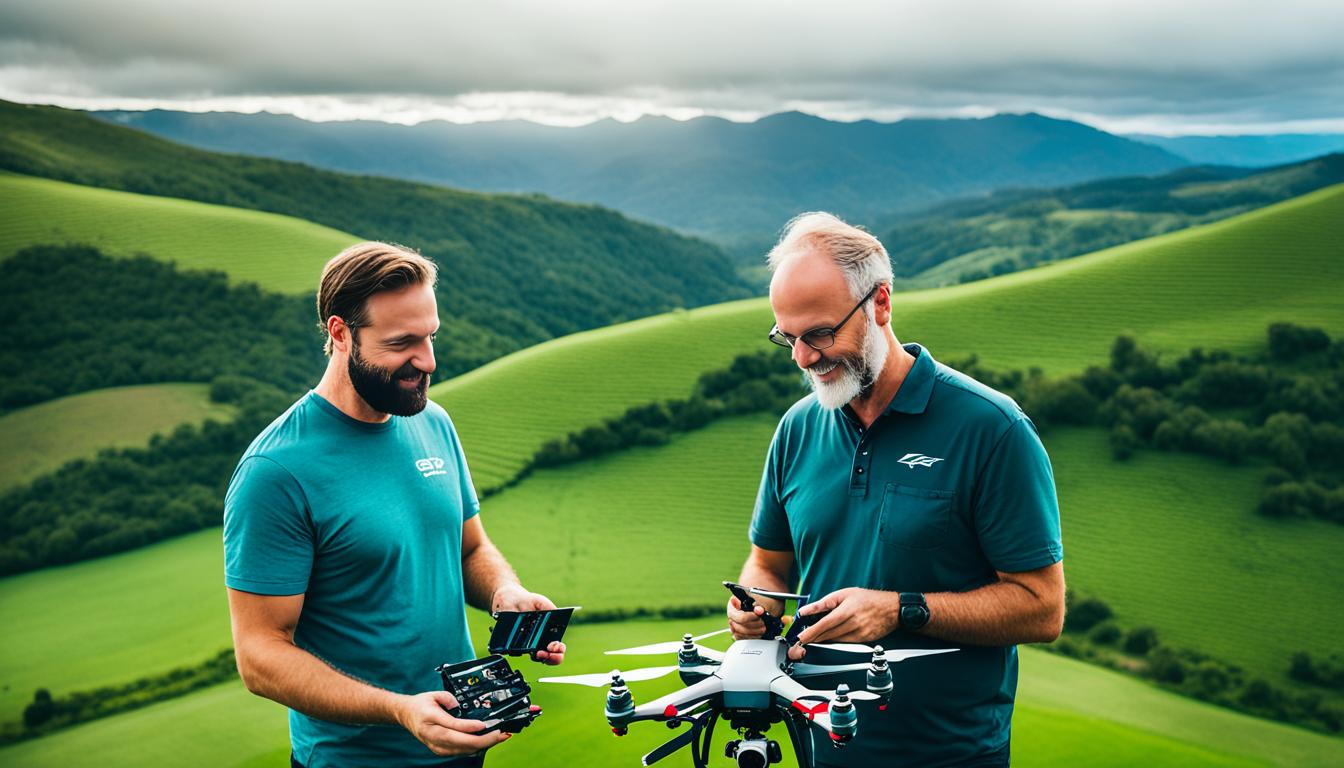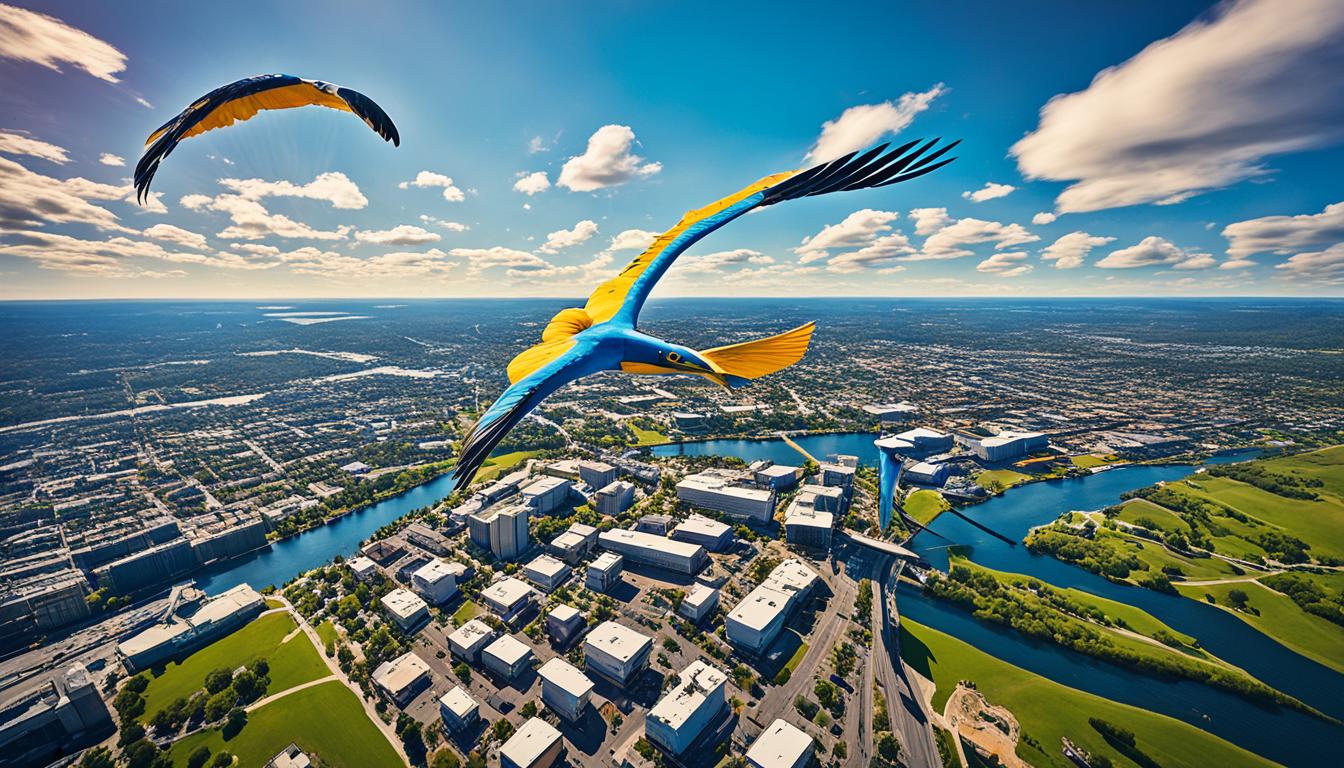Welcome to our beginner’s guide to drone photography! Whether you’re an experienced photographer looking to expand your creative horizons or a beginner who wants to explore the exciting world of aerial photography, this guide is designed to help you get started. We’ll cover everything from the basic background of drone photography to camera settings, shooting tips, and post-processing techniques. So let’s dive in and discover the incredible possibilities that drone photography has to offer!
Key Takeaways:
- Drone photography allows you to capture stunning aerial images from unique perspectives.
- Understanding the basics of cameras and their features is crucial for beginner photographers.
- Adjusting camera settings like image format, color, and exposure ensures optimal results.
- Choosing the right equipment, including drones, cameras, gimbals, and batteries, is essential.
- Complying with federal, state, and local drone regulations is necessary for safe and legal operations.
Camera Basics for Beginner Photographers
When starting with drone photography, it is important to understand the basics of cameras and their features. Most drones come with built-in cameras, and there are different factors to consider when choosing the best camera for your drone. These factors include image resolution, image capture rate, live streaming capabilities, gimbals, and battery capacity. It is also important to consider your specific needs and the type of projects you plan to undertake with your drone.
“Understanding the camera basics and choosing the right camera for your drone is essential for capturing stunning aerial photographs.”
One of the key considerations is the image resolution. Higher resolution cameras can capture more detail and produce sharper images. For beginners, a camera with a minimum resolution of 12 megapixels is recommended to ensure good image quality.
The image capture rate refers to how many frames per second the camera can capture. This is important for capturing fast-paced action or creating smooth videos. Look for cameras with a higher capture rate (at least 30 frames per second) if you plan to shoot dynamic scenes.
Live streaming capabilities allow you to view the camera’s feed in real time on your mobile device or remote control. This feature is useful for framing your shots and adjusting settings while the drone is in the air. Consider cameras that offer live streaming capabilities for a better shooting experience.
Gimbals are stabilizing mechanisms that help reduce camera shake during flight. They provide smoother footage and allow for more precise control over the camera’s angle. Look for drones with built-in gimbals or compatible gimbals that offer improved stability.
Battery capacity is an important factor to consider as it determines how long you can fly your drone and capture footage. Larger capacity batteries allow for longer flight times, giving you more time to explore and capture your desired shots. It is recommended to have spare batteries on hand for extended shooting sessions.
Take into account your specific needs and the type of projects you plan to undertake with your drone. Whether you are capturing landscapes, action shots, or aerial videos, choosing a camera that aligns with your goals will result in better outcomes.
Comparison of Camera Features
| Camera Feature | Description |
|---|---|
| Image Resolution | Determines the level of detail and sharpness in your photos. Higher resolution produces clearer images. |
| Image Capture Rate | Refers to the number of frames captured per second. Higher capture rates are beneficial for shooting fast-paced action. |
| Live Streaming Capabilities | Allows you to view the camera feed in real time on your mobile device or remote control. |
| Gimbal | A stabilizing mechanism that reduces camera shake and provides smoother footage. |
| Battery Capacity | Determines how long you can fly your drone and capture footage. |
With a good understanding of camera basics and careful consideration of the features mentioned above, you can choose a camera that suits your needs as a beginner photographer. Remember to always keep practicing and experimenting with different settings to get the best shots from your drone.
Camera Settings for Drone Photography
Before taking flight with your drone, it’s crucial to master the art of adjusting camera settings for the best possible results. By understanding and optimizing camera settings, you can elevate your drone photography to new heights. Here are some key considerations to keep in mind:
Choose the Right Image Format
The image format you select can significantly impact the quality and flexibility of your drone photos. It’s recommended to shoot in a combination of JPEG and RAW formats. While JPEG offers convenience and smaller file sizes, RAW captures more detailed information and provides greater latitude for post-processing adjustments. This allows you to correct mistakes, enhance colors, and control exposure to achieve the best final image.
Adjust Color and Exposure Settings
When it comes to color and exposure settings, finding the perfect balance is essential. Experiment with different white balance settings to ensure accurate color representation in your photographs. Adjust the camera’s exposure compensation to control the brightness of the image, especially when shooting in challenging lighting conditions. Being mindful of exposure will help you capture well-balanced and visually appealing aerial shots.
“By following these steps, you can ensure that you capture high-quality images and have more flexibility in post-processing.”
Moreover, consider using the histogram feature on your drone’s camera display to evaluate the tonal distribution of your image. This tool allows you to identify overexposed or underexposed areas and make adjustments accordingly. By achieving proper exposure, you can preserve important details and ensure an optimal image.
Understanding the Impact of Settings
Each camera setting has a direct impact on the final image. For instance, the ISO setting determines the camera’s sensitivity to light. While increasing the ISO can help capture clearer images in low-light situations, it can also introduce noise or graininess. Finding the right balance between ISO, aperture, and shutter speed is key to capturing stunning drone photos with optimal sharpness and clarity.

Equipment: What You’ll Need for Drone Photography
When it comes to drone photography, having the right equipment is essential. To capture breathtaking aerial shots, you’ll need a combination of reliable drones, stabilizing gimbals, high-quality cameras, long-lasting batteries, and more. Here’s a breakdown of the key equipment you’ll need:
Drones
At the heart of drone photography is, of course, the drone itself. Choose a drone that meets your specific needs and budget. Popular options include the DJI Mavic Air 2, Autel Evo II, and the Skydio 2. These drones offer advanced features, excellent flight capabilities, and high-resolution cameras for stunning image quality.
Gimbal
A gimbal is crucial for stabilizing the camera and minimizing shake and vibrations during flight. It allows for smoother and more professional-looking footage and images. Drones often come with built-in gimbals, but you can also purchase detachable gimbals for more flexibility and control over your camera stabilization.
Camera
A drone with a high-quality camera is essential for capturing stunning aerial images. Look for a camera that offers a high resolution, adjustable aperture, and the ability to shoot in RAW format for maximum post-processing flexibility. Popular camera choices for drone photography include the Hasselblad cameras in DJI drones, as well as cameras from Sony and GoPro.
Batteries and Chargers
Having spare batteries and a reliable charger is a must for prolonged drone photography sessions. Ensure you have extra batteries that are compatible with your drone, allowing you to extend your flight time. Invest in a high-quality charger that can safely charge multiple batteries simultaneously to keep you in the air for longer.
Transmitter or Controller
A transmitter or controller is what allows you to operate and control your drone. Make sure it has a reliable connection and intuitive controls that suit your flying style. Many drones come with built-in controllers, but you can also find separate controllers with customizable settings for more precise maneuvering.
FPV Goggles or Screen
For a truly immersive experience, consider investing in First Person View (FPV) goggles or a large screen for real-time viewing of your drone’s camera feed. This allows you to see what the drone sees, giving you a more accurate perspective of your shots and enabling precise framing.
Detailed List of Equipment
| Equipment | Description |
|---|---|
| Drone | A high-quality drone with advanced flight capabilities and a reliable camera. |
| Gimbal | A stabilizing device that ensures smooth footage by minimizing shake and vibrations. |
| Camera | A camera with adjustable settings, high resolution, and the ability to shoot in RAW format. |
| Batteries | Spare batteries to extend flight time and keep you in the air for longer. |
| Charger | A reliable charger that can safely charge multiple batteries simultaneously. |
| Transmitter or Controller | A device that allows you to operate and control the drone during flight. |
| FPV Goggles or Screen | Eyewear or a large screen for real-time viewing of the drone’s camera feed. |
By ensuring that you have the right drone photography equipment, you’ll be well-equipped to capture stunning aerial shots and elevate your photography to new heights.
Federal, State, and Local Drone Regulations & No-Fly Zones
Before taking flight with your drone, it is essential to familiarize yourself with the regulations and laws that govern drone use. These regulations ensure the safety of airspace and individuals on the ground. Compliance with the rules not only protects others but also safeguards your own interests as a responsible drone pilot.
Drone regulations vary and are applicable at different levels: federal, state, and local. In the United States, the Federal Aviation Administration (FAA) is the primary authority responsible for overseeing drone operations. They have established rules and guidelines for safe and legal drone use.
One of the key requirements in the United States is the registration of drones weighing more than 0.55 pounds (250 grams) with the FAA. This registration process helps in the identification of drone owners and promotes accountability.
To further ensure safety, the FAA has also implemented a pilot certification process. This process involves obtaining a Flyer ID and an Operator ID, which must be displayed on your drone.
In addition to federal regulations, it is essential to be aware of state and local rules that may exist in your area. These regulations may impose additional restrictions or requirements for drone operation based on local considerations.
No-fly zones are specific areas where drone flights are strictly prohibited due to safety or privacy concerns. Examples include airports, military installations, and national parks. It is crucial to respect these restrictions and avoid flying your drone in designated no-fly zones.
| Regulation Type | Authority | Key Points |
|---|---|---|
| Federal Regulations | Federal Aviation Administration (FAA) | – Drone registration for drones above 0.55 pounds (250 grams) – Obtain a Flyer ID and Operator ID – Adhere to FAA guidelines and restrictions |
| State Regulations | State Aviation Authorities | – Additional rules and restrictions specific to each state – May require permits or licenses for commercial drone operations |
| Local Regulations | Local Authorities | – Additional rules specific to cities or municipalities – No-fly zones and restrictions based on local considerations |
Staying informed about the latest drone regulations and no-fly zones is crucial for drone pilots. The Federal Aviation Administration (FAA) and Civil Aviation Authorities of other countries regularly update their guidelines to adapt to evolving technology and ensure safety in the skies.
Remember, by respecting and complying with the regulations, you contribute to the responsible and safe integration of drones into our airspace. Stay informed, fly responsibly, and enjoy the wonders of drone photography within the legal boundaries.
Learn to Fly a Drone Before You Attach a Camera
Flying a drone can be an exhilarating experience, especially when you’re capturing stunning aerial photos or videos. However, before you dive into the world of drone photography, it’s crucial to learn the basics of piloting a drone. Mastering drone piloting skills will not only enhance your ability to control the drone but also ensure the safety of your flights. Let’s explore the importance of learning to fly a drone and the essential skills you need to develop for a successful drone photography journey.

So why is it necessary to learn how to fly a drone before attaching a camera to it?
Flying a drone requires skill and practice. It’s like learning to ride a bike before embarking on a long cycling trip. By mastering the art of drone piloting, you’ll be able to maneuver the drone confidently, capture smooth shots, and fly safely within legal limits. It’s all about building a solid foundation of drone control and safety before adding the complexity of a camera into the mix.
What are the key drone piloting skills you need to acquire?
When learning to fly a drone, there are several essential skills that you should focus on:
- Understanding the basic controls: Familiarize yourself with the different controls of the drone, such as throttle, pitch, yaw, and roll. Practice maneuvering the drone in various directions to gain confidence in controlling its movements.
- Mastering the flight modes: Most drones offer different flight modes, such as GPS mode, altitude hold, or manual mode. Learn how to switch between these modes and understand their effects on the drone’s behavior.
- Practicing takeoffs and landings: Landing and taking off smoothly are crucial for safe and controlled flights. Practice these maneuvers in open areas without obstacles to avoid any potential damage to your drone.
- Learning emergency procedures: Accidents can happen even to experienced drone pilots. Prepare yourself by understanding and practicing emergency procedures, such as safely landing the drone in case of a low battery or unexpected obstacles.
By dedicating time to learn these essential skills, you’ll develop the confidence and competence needed to handle a drone effectively. Remember, flying a drone is not just about capturing stunning images but also ensuring the safety of yourself, others, and the environment.
Drone Safety Guidelines
Alongside learning to fly a drone, it’s essential to follow safety guidelines to prevent accidents and comply with regulations. Here are some key safety tips to keep in mind:
- Observe the “line of sight” rule: Keep the drone within your visual line of sight at all times to maintain control and avoid collisions.
- Avoid flying over people and property: Fly in designated areas away from crowds and private property to protect the privacy and safety of others.
- Check for no-fly zones: Be aware of restricted areas where flying drones is prohibited due to security or privacy concerns.
- Respect wildlife and the environment: Avoid flying near wildlife, sensitive habitats, or noise-sensitive areas to minimize disturbances.
- Stay updated on regulations: Regularly check and comply with federal, state, and local regulations related to drone operations in your area.
By adhering to these safety guidelines, you can enjoy a responsible and enjoyable drone flying experience while minimizing any potential risks.
| Benefit | Description |
|---|---|
| Enhanced Control | Mastering drone piloting skills allows you to control the drone more precisely and confidently, resulting in smoother flights and better aerial photography. |
| Improved Safety | Learning to fly a drone before attaching a camera enhances safety by reducing the risk of accidents and collisions, protecting both your equipment and others around you. |
| Legal Compliance | Flying a drone without proper piloting skills and disregarding safety guidelines may lead to legal repercussions. Learning to fly a drone ensures compliance with regulations. |
Choosing the Right Drone for Beginners
When starting with drone photography, it is recommendable to choose a beginner-friendly drone. These drones are often more affordable and easier to operate. Some popular options for beginner drones include the Ryze Tello, Holy Stone HS175D, DJI Mini 3, and Potensic A20. It is important to consider factors such as camera capabilities, flight time, ease of use, and overall performance when selecting the right drone for your needs.
Camera Capabilities
When choosing a beginner drone, pay attention to the camera capabilities. Look for drones that offer high-resolution imaging and stable video recording. Some drones also come with built-in cameras that are specifically designed for aerial photography, allowing you to capture stunning shots from unique perspectives.
Flight Time
Consider the flight time of the drone, which refers to how long the drone can stay in the air on a single charge. A longer flight time allows for more extended and uninterrupted shooting sessions. Look for drones that offer decent flight times to maximize your photography opportunities.
Ease of Use
As a beginner, it is essential to choose a drone that is easy to fly and control. Look for features such as beginner modes, auto takeoff and landing, and obstacle avoidance systems that can assist you in your learning process. These features can help you build confidence and improve your piloting skills.
Overall Performance
Consider the overall performance of the drone, including its stability, speed, and maneuverability. A stable and responsive drone will allow you to capture smooth and professional-looking footage. Look for drones that offer intuitive controls and have a good reputation for performance and reliability.
By considering these factors and researching different drone models, you can make an informed decision when choosing the right drone for your beginner photography needs. With the right drone in hand, you can embark on your drone photography journey with confidence and capture stunning aerial images.
Conclusion
Drone photography opens up a new and exciting world of capturing stunning aerial images. With the combination of technical skills, creativity, and adherence to regulations, you can embark on a thrilling journey of exploring the endless possibilities it offers.
By following the basics discussed in this guide, you can confidently get started with drone photography. Understand the camera basics, adjust the settings, and choose the right equipment that suits your needs. Remember to prioritize safety and respect regulations to ensure responsible drone operations.
As you progress in your drone photography journey, continue learning and improving your skills. Explore different shooting techniques, experiment with composition, and push the boundaries of your creativity. The more you practice and explore, the more you will discover the incredible beauty that can be captured from the skies.
So, grab your drone, get ready to soar, and embrace the world of drone photography. Unleash your creativity and capture breathtaking moments from unique perspectives. It’s time to elevate your photography to new heights!
FAQ
What factors should I consider when choosing a camera for my drone?
When choosing a camera for your drone, consider factors such as image resolution, image capture rate, live streaming capabilities, gimbals, and battery capacity. It’s important to choose a camera that suits your specific needs and the type of projects you plan to undertake with your drone.
What camera settings should I adjust for drone photography?
For optimal drone photography results, adjust settings such as the image format (JPG+RAW), color, and exposure. These adjustments give you more flexibility in post-processing and help capture high-quality images from your drone.
What equipment do I need for drone photography?
To get started with drone photography, you’ll need a drone with a built-in camera, a gimbal to stabilize the camera, a suitable camera for aerial photography, a transmitter or controller to operate the drone, FPV goggles or a screen for real-time viewing, batteries, battery charger, and other accessories depending on your specific needs.
What are the regulations and laws I need to follow for drone use?
It’s crucial to understand and comply with regulations and laws governing drone use, including federal, state, and local regulations, as well as any restrictions in no-fly zones. In the United States, drone registration may be required for certain weights, and flyer ID and operator ID may also be necessary.
Should I learn to fly a drone before attaching a camera?
Yes, it’s highly recommended to gain proficiency in flying a drone before attaching a camera. Take the time to learn how to control the drone, maneuver it safely, and follow safety guidelines to ensure smooth and successful flights when capturing aerial photos or videos.
What are some beginner-friendly drones for photography?
There are several beginner-friendly drones suitable for photography, including the Ryze Tello, Holy Stone HS175D, DJI Mini 3, and Potensic A20. Consider factors such as camera capabilities, flight time, ease of use, and overall performance when selecting the right drone for your needs.
How do I get started with drone photography?
To get started with drone photography, familiarize yourself with the basics of cameras and their features, adjust the camera settings to optimize your photos, choose the right equipment for your needs, understand and comply with drone regulations and laws, learn to fly a drone proficiently, and select a beginner-friendly drone that suits your requirements. With these steps, you’ll be on your way to exploring the endless possibilities of drone photography.
How Important is Regular Maintenance for Drone Photography?
Regular maintenance is essential for drone photography. Following these tips for drone maintenance will ensure that your equipment is in top condition for capturing stunning aerial shots. From checking for loose screws to cleaning the lens, taking care of your drone will help prolong its lifespan and maintain its performance.




